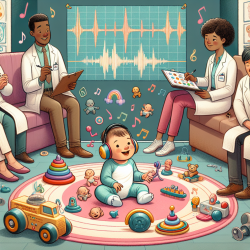In the realm of pediatric audiology, understanding the nuances of auditory development is crucial for early detection and intervention of hearing impairments. The research paper "Development of Frequency Perception in Infants and Children" by K.D. Fenwick and B.A. Morrongiello, and its commentary by Debra L.C. Zelisko, offers invaluable insights into the developmental trends of auditory functioning and the methodological challenges of assessing young patients. This blog aims to distill key findings from the research and commentary, offering practitioners actionable strategies to refine their clinical practices and encourage further exploration in this vital area.
Understanding Frequency Perception in Young Patients
The research highlights the developmental trajectory of frequency perception in infants and young children, noting a greater sensitivity to lower frequencies, which gradually balances out as the child ages. This evolving sensitivity underscores the importance of age-appropriate testing and intervention strategies. For practitioners, acknowledging these developmental trends is the first step in tailoring assessment and intervention methods to better meet the needs of their young patients.
Challenges in Current Testing Methods
Conventional audiometric techniques often fall short when applied to infants and young children due to their inability to communicate or cooperate in the same manner as adults. The use of Visually Reinforced Audiometry (VRA) and the conditioned head-turn technique are highlighted as more effective approaches. However, these methods come with their own set of challenges, including the potential for non-auditory cues influencing the child's response. The commentary suggests the potential for improvement in test reliability through the use of masking headphones with a talk-over option, which could minimize external cues while maintaining communication between examiners.
Recommendations for Clinical Practice
- Adopt Two-Examiner Testing: Utilizing a two-examiner approach can enhance the accuracy of VRA by ensuring one examiner can focus on observing and reinforcing the child's responses while the other manages the audiometer.
- Consider Age-Related Sensitivity: Adjust testing protocols to account for the known developmental trends in frequency sensitivity, ensuring that assessments are appropriately challenging without being outside the child's current perceptual capabilities.
- Improve Test Reliability: Explore the use of masking headphones with communication capabilities to reduce non-auditory cues and enhance the reliability of test results.
- Early Intervention: Given the critical nature of early auditory development, practitioners should prioritize early detection and intervention, utilizing the most reliable testing methods available to identify any impairments as soon as possible.
Encouraging Further Research
The commentary underscores the necessity for ongoing research to fill the gaps in our understanding of infant and child frequency perception. Collaboration between researchers and clinicians is essential to develop more sophisticated testing methods that can accurately assess auditory function in this population. Practitioners are encouraged to stay abreast of new research findings and consider how these insights might be integrated into their clinical practice.
In conclusion, "Development of Frequency Perception in Infants and Children" provides a foundational understanding of auditory development and the challenges inherent in pediatric audiology. By implementing the suggested clinical practices and advocating for further research, practitioners can enhance their ability to accurately assess and intervene in hearing impairments during the critical early years of auditory development. For those interested in delving deeper into the research and its implications for clinical practice, Commentary on "Development of Frequency Perception in Infants and Children" is an essential read.










